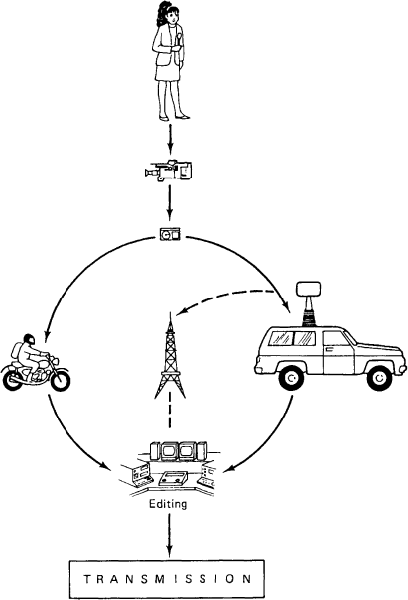Camera and Sound Equipment
The development of camera equipment has come a long way since the days when the newsreels went to war with the 35 mm gear similar to that used in the making of feature films. First there was a switch to the lighter, more mobile 16 mm–originally derided an amateur format–complete with magnetic sound track, fast chemical processing and updated editing techniques. Twenty years later, by the end of the 1970s, had come a further revolution which saw film virtually swept away altogether in favour of re-usable, instantly replayable videotape. The after-shocks of that upheaval are still being felt as developments in digital technology spearhead the drive towards more compact, one-piece digital video cameras (DVC) using tapes the size of matchboxes or even disks to record material.
Electronic news gathering
The commonly accepted term for the lightweight video equipment used in news is Electronic News Gathering (ENG), although other terminology, including Electronic Journalism (EJ), and Portable Single Camera (PSC) also exists.
The first widely used ENG equipment consisted of a camera weighing a few pounds/kilos and a separate, portable videocassette machine on which both picture and sound were recorded on to three-quarter-inch (19 mm) tape. This was followed first by Betacam, a half-inch (12.5 mm) tape system introduced by Sony, the Japanese company, then by Betacam SP (Superior Performance), a format which became the industry standard.
Enter the camcorder
The incorporation of the recorder within the camera body itself was the next logical development. It had other important implications, too, for it made the separate sound recordist redundant, as one person could now operate the equipment by him- or herself, using the camera-mounted microphone to capture the sound. Where necessary extra microphones could be plugged in and handled by the reporter. For news, this principle of ‘single-crewing’, with the users employing any one of a broadening range of professional standard camcorders, has become widely adopted, offering the additional prospect of the complete ‘one-man/woman band’–camera-operator and journalist all rolled into one.
The advantage of ENG
The main advantage for news work is its mobility and speed, as there is no wasteful processing time. It is also extremely versatile in other ways. The raw material can be extracted and handed over for despatch and editing; the signals can be transmitted direct to base or by an intermediate microwave link; they can be transmitted live and recorded at the same time. Tape in particular is cheap and re-useable, and the pictures and sound can be transferred by playing them from cassette to cassette or cassette to non-linear editor. Material edited electronically is never actually ‘cut’, the original remaining intact.

Advantages of ENG
One-piece camcorder offers speed and flexibility. Sound and pictures can be recorded onto tape or disk for delivery by hand or transmitted over microwave link direct to home base, or to an intermediate point. ‘Live’ transmission facilities are also possible, if necessary via satellite.
